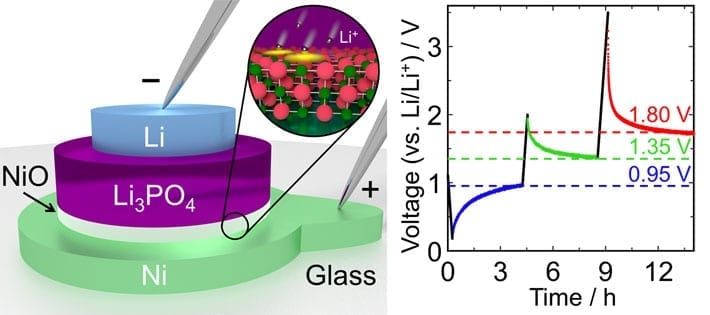
The stacked layers in the proposed memory device form a mini-battery that can be quickly and efficiently switched between three different voltage states (0.95 V, 1.35 V, and 1.80 V).
Scientists at the Tokyo Institute of Technology (Tokyo Tech) and the University of Tokyo (UTokyo) developed a new three-valued memory device inspired by solid lithium-ion batteries. The proposed device, which has an extremely low energy consumption, may be key for the development of more energy-efficient and faster random-access memories (RAMs), which are ubiquitous in modern computers.
Virtually all digital devices that perform any sort of processing of information require not only a processing unit, but also a quick memory that can temporarily hold the inputs, partial results, and outputs of the operations performed. In computers, this memory is referred to as dynamic random-access memory, or DRAM. The speed of DRAM is very important and can have a significant impact in the overall speed of the system. In addition, lowering the energy consumption of memory devices has recently become a hot topic to achieve highly energy-efficient computing. Therefore, many studies have focused on testing out new memory technologies to surpass the performance of conventional DRAM.
The most basic unit in a memory chip are its memory cells. Each cell typically stores a single bit by adopting and holding one of two possible voltage values, which correspond to a stored value of either “0” or “1”. The characteristics of the individual cell largely determine the performance of the overall memory chip. Simpler and smaller cells with high speed and low energy consumption would be ideal to take highly efficient computing to the next level.
A research team from Tokyo Tech led by Prof. Taro Hitosugi and student Yuki Watanabe recently reached a new milestone in this area. These researchers had previously developed a novel memory device inspired by the design of solid lithium-ion batteries. It consisted of a stack of three solid layers made of lithium, lithium phosphate, and gold. This stack is essentially a miniature low-capacity battery that functions as a memory cell; it can be quickly switched between charged and discharged states that represent the two possible values of a bit. However, gold combines with lithium to form a thick alloy layer, which increases the amount of energy required to switch from one state to the other.
In their latest study, the researchers created a similar three-layer memory cell using nickel instead of gold. They expected better results using nickel because it does not easily form alloys with lithium, which would lead to lower energy consumption when switching. The memory device they produced was much better than the previous one; it could actually hold three different voltage states instead of two, meaning that it is a three-valued memory device. “This system can be viewed as an extremely low-capacity thin-film lithium battery with three charged states,” explains Prof. Hitosugi. This is a very interesting feature that has potential advantages for three-valued memory implementations, which may be more area efficient.
The researchers also found that nickel forms a very thin nickel oxide layer between the Ni and the lithium phosphate layers (see Fig. 1), and this oxide layer is essential for the low-energy switching of the device. The oxide layer is much thinner than that of the gold–lithium alloys that formed in their previous device, which means that this new “mini-battery” cell has a very low capacity and is therefore quickly and easily switched between states by applying minuscule currents. “The potential for extremely low energy consumption is the most noteworthy advantage of this device,” remarks Prof. Hitosugi.
Increased speed, lower energy consumption, and smaller size are all highly demanded features in future memory devices. The memory cell developed by this research team is a very promising stepping stone toward much more energy-efficient and faster computing.
Learn more: Small, fast, and highly energy-efficient memory device inspired by lithium-ion batteries
The Latest Google Headlines on:
Faster computing
[google_news title=”” keyword=”faster computing” num_posts=”10″ blurb_length=”0″ show_thumb=”left”]
The Latest Bing News on:
Faster computing
- AI Lexicon: Q is for qubits and quantum computingon May 17, 2024 at 8:06 am
Today's digital computers are fast, much faster — as we are often reminded — than the computers that got humans to the moon in 1969. Supercomputers are incredibly fast — their processors use what's ...
- Scientists breakthrough with 'world's purest silicon' set to power next-gen computerson May 16, 2024 at 10:02 pm
Scientists have created an ultra-pure form of silicon that may be the much-needed foundation for the next generation of computing.
- Robert Dennard, IBM Inventor Whose Chip Changed Computing, Dies at 91on May 16, 2024 at 4:06 pm
He invented DRAM, the technology that allowed for the faster and higher-capacity memory storage that is the basis for modern computing.
- Wall Street Favorites: 3 Quantum Computing Stocks With Strong Buy Ratings for May 2024on May 16, 2024 at 1:11 pm
InvestorPlace - Stock Market News, Stock Advice & Trading Tips Quantum computing has the potential to usher in a new era of computing power.
- New research to make digital transactions quantum safe and 20 times fasteron May 16, 2024 at 10:42 am
A team of experts, including Monash University researchers, has developed a new technique to implement quantum-safe digital signatures twenty times faster, resulting in speedier and safer online ...
- Scientists prove 'quantum theory' that could lead to ultrafast magnetic computingon May 16, 2024 at 4:00 am
Superfast magnetic memory devices are possible after scientists engineer way to use lasers to magnetize non-magnetic materials.
- 8 Best Quantum Computing Stocks to Buy in 2024on May 14, 2024 at 1:00 pm
“This demonstrates what will fast become the expected standard for the entire quantum computing sector,” Quantinuum noted. Honeywell should continue to profit from its big investment in ...
- Graphene and faster computer chipson May 14, 2024 at 6:02 am
The new material has superior properties. It can be used to make computer chips with much faster switches, that generate less waste heat than silicon chips. More research is needed before the ...
- Quantum computing takes a giant leap forward with breakthrough discoveryon May 12, 2024 at 2:45 pm
Scientists have produced an enhanced, ultra-pure form of silicon that is crucial for paving the way towards scalable quantum computing.
- The Future Of Climate Could Be In Quantum Computingon May 7, 2024 at 7:43 am
Quantum computing has a number of advantages over other technologies in terms of accelerating our progress with reducing climate change.
The Latest Google Headlines on:
Faster random-access memory
[google_news title=”” keyword=”faster random-access memory” num_posts=”10″ blurb_length=”0″ show_thumb=”left”]
The Latest Bing News on:
Faster random-access memory
- Robert Dennard, IBM Inventor Whose Chip Changed Computing, Dies at 91on May 16, 2024 at 4:06 pm
He invented DRAM, the technology that allowed for the faster and higher-capacity memory storage that is the basis for modern computing.
- What does RAM do for gaming? Here’s why you need to careon May 13, 2024 at 6:41 am
Your computer’s RAM (that's "random access memory") holds the key to its performance. To play your absolute best, you need to know what RAM does for gaming.
- How to pick the perfect laptop in 2024on May 12, 2024 at 7:00 am
Laptops offer many different varieties of screen size, processors and storage. Kurt "CyberGuy" Knutsson presents his guide for the best options.
- Windows 11 Is Changing Its Unit of Measure for Memory from MHz to MT/s via a New Insider Beta Updateon May 8, 2024 at 6:05 am
Windows 11 is keeping up with the times by updating a decades-old means of reporting memory speed to a more accurate version.
- How to Test Your Computer's RAM for Problemson April 28, 2024 at 5:00 am
Run "Windows Memory Diagnostic" from the Start Menu, and then restart your PC to check your RAM for problems. You can also download and install MemTest86 for a more thorough RAM test.
- How to choose the best RAM for your PC in 2024on April 23, 2024 at 5:00 pm
RAM stands for Random Access Memory, and more precisely ... be it software or your operating system, making it faster to fetch when the CPU requests it. It differs from regular storage, such ...
- RAM Characteristicson July 20, 2018 at 10:57 am
Memory modules are labelled with either SDRAM (Synchronous Dynamic Random Access Memory) or DDR (Double Data Rate). DDR RAM, as the "double data rate" name suggests, offers much faster speeds than ...
- How to Reduce Pagefile.Sys Sizeon July 20, 2018 at 7:58 am
Windows creates a Pagefile.sys file in "C" drive's root directory, and it is used to swap data between the hard drive and the faster random access memory, or RAM. By default, this file can be up ...
- SRAM Modules Informationon February 11, 2018 at 6:56 am
SRAM memory modules use static random access memory (SRAM), a type of memory that is faster, more reliable, and more expensive than dynamic random access memory (DRAM). Unlike DRAM computer memory ...
- Random Access Memory Definitionon December 27, 2016 at 5:12 pm
Random Access Memory is temporary memory used to store ... the more data the computer can store there, which can lead to faster performance. Any information that is stored in RAM when you turn ...











